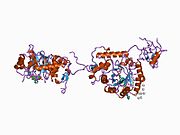IMPDH2
Appearance
| IMPDH2 | |||||||||||||||||||||||||||||||||||||||||||||||||||
|---|---|---|---|---|---|---|---|---|---|---|---|---|---|---|---|---|---|---|---|---|---|---|---|---|---|---|---|---|---|---|---|---|---|---|---|---|---|---|---|---|---|---|---|---|---|---|---|---|---|---|---|
 | |||||||||||||||||||||||||||||||||||||||||||||||||||
| |||||||||||||||||||||||||||||||||||||||||||||||||||
| Identifiers | |||||||||||||||||||||||||||||||||||||||||||||||||||
| Aliases | IMPDH2, IMPD2, IMPDH-II, IMP (inosine 5'-monophosphate) dehydrogenase 2, inosine monophosphate dehydrogenase 2 | ||||||||||||||||||||||||||||||||||||||||||||||||||
| External IDs | OMIM: 146691; MGI: 109367; HomoloGene: 48919; GeneCards: IMPDH2; OMA:IMPDH2 - orthologs | ||||||||||||||||||||||||||||||||||||||||||||||||||
| |||||||||||||||||||||||||||||||||||||||||||||||||||
| |||||||||||||||||||||||||||||||||||||||||||||||||||
| |||||||||||||||||||||||||||||||||||||||||||||||||||
| |||||||||||||||||||||||||||||||||||||||||||||||||||
| Wikidata | |||||||||||||||||||||||||||||||||||||||||||||||||||
| |||||||||||||||||||||||||||||||||||||||||||||||||||
Inosine-5'-monophosphate dehydrogenase 2, also known as IMP dehydrogenase 2, is an enzyme that in humans is encoded by the IMPDH2 gene.[5][6][7]
Function
IMP dehydrogenase 2 is the rate-limiting enzyme in the de novo guanine nucleotide biosynthesis. It is thus involved in maintaining cellular guanine deoxy- and ribonucleotide pools needed for DNA and RNA synthesis. IMPDH2 catalyzes the NAD-dependent oxidation of inosine-5'-monophosphate into xanthine-5'-monophosphate, which is then converted into guanosine-5'-monophosphate.[5]
Clinical significance
This gene is up-regulated in some neoplasms, suggesting it may play a role in malignant transformation.[5]
See also
References
- ^ a b c GRCh38: Ensembl release 89: ENSG00000178035 – Ensembl, May 2017
- ^ a b c GRCm38: Ensembl release 89: ENSMUSG00000062867 – Ensembl, May 2017
- ^ "Human PubMed Reference:". National Center for Biotechnology Information, U.S. National Library of Medicine.
- ^ "Mouse PubMed Reference:". National Center for Biotechnology Information, U.S. National Library of Medicine.
- ^ a b c "Entrez Gene: IMP (inosine monophosphate) dehydrogenase 2".
- ^ Natsumeda Y, Ohno S, Kawasaki H, Konno Y, Weber G, Suzuki K (March 1990). "Two distinct cDNAs for human IMP dehydrogenase". J. Biol. Chem. 265 (9): 5292–5. PMID 1969416.
- ^ Kost-Alimova MV, Glesne DA, Huberman E, Zelenin AV (1998). "Assignment1 of inosine '-monophosphate dehydrogenase type 2 (IMPDH2) to human chromosome band 3p21.2 by in situ hybridization". Cytogenet. Cell Genet. 82 (3–4): 145–6. doi:10.1159/000015088. PMID 9858805.
Further reading
- Garat A, Cauffiez C, Hamdan-Khalil R, et al. (2009). "IMPDH2 genetic polymorphism: a promoter single-nucleotide polymorphism disrupts a cyclic adenosine monophosphate responsive element". Genet Test Mol Biomarkers. 13 (6): 841–7. doi:10.1089/gtmb.2009.0096. PMID 19810816.
- Wang J, Zeevi A, Webber S, et al. (2007). "A novel variant L263F in human inosine 5'-monophosphate dehydrogenase 2 is associated with diminished enzyme activity". Pharmacogenet. Genomics. 17 (4): 283–90. doi:10.1097/FPC.0b013e328012b8cf. PMID 17496727.
- So HC, Fong PY, Chen RY, et al. (2010). "Identification of neuroglycan C and interacting partners as potential susceptibility genes for schizophrenia in a Southern Chinese population". Am. J. Med. Genet. B Neuropsychiatr. Genet. 153B (1): 103–13. doi:10.1002/ajmg.b.30961. PMID 19367581.
- Grinyó J, Vanrenterghem Y, Nashan B, et al. (2008). "Association of four DNA polymorphisms with acute rejection after kidney transplantation". Transpl. Int. 21 (9): 879–91. doi:10.1111/j.1432-2277.2008.00679.x. PMID 18444945.
- Ohmann EL, Burckart GJ, Brooks MM, et al. (2010). "Genetic polymorphisms influence mycophenolate mofetil-related adverse events in pediatric heart transplant patients". The Journal of Heart and Lung Transplantation. 29 (5): HASH(0x2dc9fd0). doi:10.1016/j.healun.2009.11.602. PMID 20061166.
- Sombogaard F, van Schaik RH, Mathot RA, et al. (2009). "Interpatient variability in IMPDH activity in MMF-treated renal transplant patients is correlated with IMPDH type II 3757T > C polymorphism". Pharmacogenet. Genomics. 19 (8): 626–34. doi:10.1097/FPC.0b013e32832f5f1b. PMID 19617864.
- Fellenberg J, Bernd L, Delling G, et al. (2007). "Prognostic significance of drug-regulated genes in high-grade osteosarcoma". Mod. Pathol. 20 (10): 1085–94. doi:10.1038/modpathol.3800937. PMID 17660802.
- Lim J, Hao T, Shaw C, et al. (2006). "A protein-protein interaction network for human inherited ataxias and disorders of Purkinje cell degeneration". Cell. 125 (4): 801–14. doi:10.1016/j.cell.2006.03.032. PMID 16713569.
- He Y, Mou Z, Li W, et al. (2009). "Identification of IMPDH2 as a tumor-associated antigen in colorectal cancer using immunoproteomics analysis". Int J Colorectal Dis. 24 (11): 1271–9. doi:10.1007/s00384-009-0759-2. PMID 19597826.
- Peñuelas S, Noé V, Ciudad CJ (2005). "Modulation of IMPDH2, survivin, topoisomerase I and vimentin increases sensitivity to methotrexate in HT29 human colon cancer cells". FEBS J. 272 (3): 696–710. doi:10.1111/j.1742-4658.2004.04504.x. PMID 15670151.
- Winnicki W, Weigel G, Sunder-Plassmann G, et al. (2010). "An inosine 5'-monophosphate dehydrogenase 2 single-nucleotide polymorphism impairs the effect of mycophenolic acid". Pharmacogenomics J. 10 (1): 70–6. doi:10.1038/tpj.2009.43. PMID 19770842.
- Patel CG, Richman K, Yang D, et al. (2007). "Effect of diabetes mellitus on mycophenolate sodium pharmacokinetics and inosine monophosphate dehydrogenase activity in stable kidney transplant recipients". Ther Drug Monit. 29 (6): 735–42. doi:10.1097/FTD.0b013e31815d8ace. PMID 18043470.
- Sanquer S, Maison P, Tomkiewicz C, et al. (2008). "Expression of inosine monophosphate dehydrogenase type I and type II after mycophenolate mofetil treatment: a 2-year follow-up in kidney transplantation". Clin. Pharmacol. Ther. 83 (2): 328–35. doi:10.1038/sj.clpt.6100300. PMID 17713475.
- Mohamed MF, Frye RF, Langaee TY (2008). "Interpopulation variation frequency of human inosine 5'-monophosphate dehydrogenase type II (IMPDH2) genetic polymorphisms". Genet. Test. 12 (4): 513–6. doi:10.1089/gte.2008.0049. PMID 18976158.
- Mannava S, Grachtchouk V, Wheeler LJ, et al. (2008). "Direct role of nucleotide metabolism in C-MYC-dependent proliferation of melanoma cells". Cell Cycle. 7 (15): 2392–400. doi:10.4161/cc.6390. PMID 18677108.
- Chen L, Petrelli R, Olesiak M, et al. (2008). "Bis(sulfonamide) isosters of mycophenolic adenine dinucleotide analogues: inhibition of inosine monophosphate dehydrogenase". Bioorg. Med. Chem. 16 (15): 7462–9. doi:10.1016/j.bmc.2008.06.003. PMID 18583139.
- Guo D, Han J, Adam BL, et al. (2005). "Proteomic analysis of SUMO4 substrates in HEK293 cells under serum starvation-induced stress". Biochem. Biophys. Res. Commun. 337 (4): 1308–18. doi:10.1016/j.bbrc.2005.09.191. PMID 16236267.
- Kudo M, Saito Y, Sasaki T, et al. (2009). "Genetic variations in the HGPRT, ITPA, IMPDH1, IMPDH2, and GMPS genes in Japanese individuals". Drug Metab. Pharmacokinet. 24 (6): 557–64. doi:10.2133/dmpk.24.557. PMID 20045992.
- Ewing RM, Chu P, Elisma F, et al. (2007). "Large-scale mapping of human protein-protein interactions by mass spectrometry". Mol. Syst. Biol. 3 (1): 89. doi:10.1038/msb4100134. PMC 1847948. PMID 17353931.
This article incorporates text from the United States National Library of Medicine, which is in the public domain.








